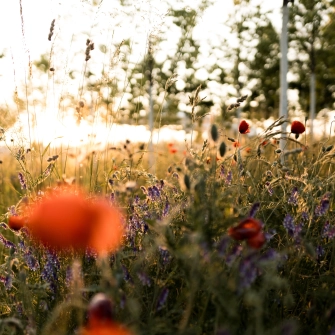

Careful garden planning is not only the first step towards your dream garden, but also the most important. Well thought-out planning helps to make optimum use of the available space. For example, it makes it possible to design different areas for different purposes. Planning ensures that the garden has a harmonious and aesthetic overall appearance. The selection of materials, plants and design elements is coordinated to create a coherent whole.
We show you the most important steps to consider when planning a garden.

Before the actual planning begins, the purpose of the garden should be carefully considered. Should it be a retreat with seating and shade-giving plants or a flowering oasis for butterflies and bees? Do you want plenty of space for your children to play? Or do you like to grow fruit and vegetables yourself and therefore need an area for raised beds or a garden bed at ground level?
A play area for children in the garden is the basis for many hours of fun in the open air. This area should inspire the little ones and at the same time leave nothing to be desired in terms of safety and care. The sandpit is a classic. It makes children's eyes light up. Children can use a variety of different shovels and molds here, giving them the opportunity to let their imagination run wild.
For a kitchen garden, you should pay attention to the choice of location: sunny and well ventilated. Whether you prefer raised beds or ground-level cultivation is entirely up to you. In addition to back-friendly gardening, there are many other aspects that make gardening in raised beds a pleasure. For example, raised beds warm up quickly in spring and stay warm for longer in fall. Ground-level beds, on the other hand, are quicker to create and much more cost-effective.
A quiet, sheltered spot at the back of the garden is ideal for a relaxation area. Make sure you choose a sunny spot that still offers the possibility of shade from trees, for example. Lounge furniture, sun loungers or other cozy seating options provide comfort. With the right plants, you can create a cozy atmosphere: shrubs provide a natural visual barrier.




Some like their garden natural and untouched, others like it with lots of fixed shapes and structures. The unique garden styles and the possibilities when designing a garden are as varied as the tastes. In any case, the choice of garden style should be carefully considered so that you feel completely at home in your own green space in the long term.
From the clearly structured Asian garden to the romantic scented and rose garden, there are many different garden styles that have their own unmistakable charm. The garden styles differ mainly in the type of planting, colors, shapes and decorative elements that give the garden its unique atmosphere.

Mediterranean garden
Olive trees, herbs and the like - a Mediterranean garden exudes Mediterranean flair and brings the vacation feeling home.

Asian garden
Water, plants, wood and stone complement each other harmoniously. This creates a relaxed atmosphere in hectic everyday life.

Natural garden
With a blooming variety of flowers, perennials and wild grasses, the idyllic natural garden invites you to relax and linger.

Romantic garden
Playful gardens invite you to dream: blooming roses, fragrant lavender, a softly rippling water feature and the gentle twittering of birds.

Family garden
A family garden offers plenty of space for undisturbed play, romping around and experimenting. A little wilderness here and there to hide in.

Minimalist garden
A minimalist garden is characterized by a clear design language and a reduced selection of materials and plants.

Pool garden
Take a dip in your own garden: whether in a classic swimming pool, an idyllic natural pool or a landscaped swimming pond - a pool garden makes it possible.

Cottage garden
Cottage gardens impress with their variety of plants. Both ornamental and useful plants can be found in a modern cottage garden.
Our style finder will help you choose the right stone for your project. Simply upload a photo of your patio or garden and cover the floor with our coverings.


It is important to set a clear budget to avoid unpleasant financial surprises. Think about how much you are willing to spend and plan accordingly to create a garden that is both beautiful and economical. Realistic scheduling will help you stay on track and avoid unnecessary stress. Consider the best times for planting and other gardening tasks to ensure your garden blooms at the right time.

At this stage, you will develop a detailed plan for your garden that includes all the elements you want to include. This includes the selection of design elements, the beds, the placement of paths and other structures. Detailed planning allows you to create a harmonious overall picture in which all elements are well coordinated. Would you like to install a pool? Should there be a lush herb garden? Or do you want to give your children plenty of space to run around and therefore want to use climbing frames and the like?
You can plan and design your garden wall precisely with our wall planning tool. Our tool also helps you to calculate the required quantity.


For us, the selection of materials and plants in harmony with the existing architecture plays a decisive role. The art of garden architecture lies in the fine balance between color and form, light and space. The character of different materials only really comes into its own when the quality of the workmanship and the knowledge of the properties of the building materials match.
The choice of garden plants should be closely coordinated with their location. Plants that have specific light requirements will thrive best if they are placed in a location that meets their needs, be it in a shady, semi-shady or sunny area. This adaptation ensures optimal growth and healthy development of the plants in your garden.